
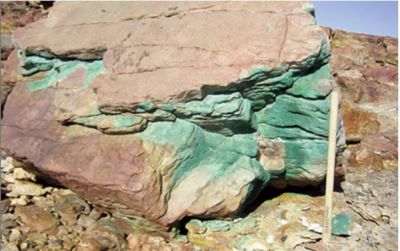
|
Home DH-Debate 2. USA and Greenland |
| 1. Introduction | 2. Early History |
| 3. The Norsemen | 4. Hans Egede |
| 5. Resources | 6. USA |
| 7. Independent Greenland | 8. Danish Politicians |
| 9. Literature |
Greenland has been a natural part of the Danish Kingdom since the Middle Ages. Nevertheless, the Danish politicians have succeeded in portraying the Greenlandic Inuits as an indigenous people, who have unjustly suffered under Danish imperialism.
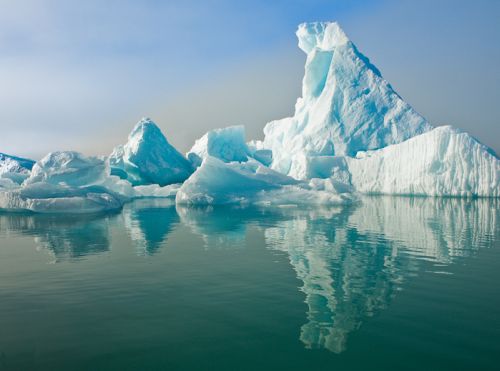
Icebergs off the coast of Greenland.
Without being forced by military defeats, epidemics or other external factors, the politicians are in full swing preparing for Greenland's brakeaway from the Danish kingdom.
A Greenlandic representative has, according to a US ambassador report to Washington, jokingly told the ambassador that "Greenland is only an oil discovery from achieving economic and political independence."
The ambitious Greenlandic politicians dream that the scattered and small population can maintain a truly independent state with its own foreign policy, defense and education system. This is clearly unrealistic and will only result in Greenland in practice being taken over by the United States.
On 21 June 2004, a self-government commission was set up on the initiative of Hans Enoksen, chairman of the national government, and Anders Fogh Rasmussen, Prime Minister, with this terms of reference: " - to ensure the greatest possible degree of equality between Greenland and Denmark and to increase the Greenlandic people's self-determination to the greatest possible extent, within the framework of the existing Commonwealth".
The Danish politicians have given the green light for Greenland to breakaway at any time they please. The ambitious Greenlandic politicians can leave the Commonwealth the day they have found enough oil and minerals to think they can fend for themselves, and then alone enjoy the benefits of selling their resources.


|
Left: Former Brazilian President da Silva declared that the resources of the Amazon should benefit the whole of Brazil and not only the few Indians who live there.
Right: Copper ore in J.C Christensen Land in North Greenland.
Have you ever heard that the Swedish or Finnish government should have plans to give the Sami people in their northern districts full independence and leave them the right to the geological resources there forever?
It has not so much as touched the consciousness of Americans to leave Alaska to the alcoholic Indians and Eskimos who have a home there. If a single state threatens secession, they will probably deploy the military, as they did when the Southern states wanted secession in 1860.
The Brazilian President da Silva declared without delay that the resources of Amazoma and the rainforest must be an asset for the whole of Brazil and not only for the Indian tribes who live there.
Nor could Cananda dream of giving it all away. When Canadian Prime Minister Stephen Harper ended a "Truth and Reconciliation Commission" and on behalf of the state gave an apology to the native population of the country, it was with the words: "It will be a first step towards the creation of - a strong Canada for all of us."
Only Danish politicians can come up with something like the Self-Government Act. They have their heads full of noble thoughts about human rights, democracy, tolerance and respect for other races and religions - but the prosperity and future of their own people seem to mean very little to them. They seem most interested in making a good impression on their foreign political colleagues.
|
|
The original terms of reference read:" - to ensure the greatest possible degree of equality between Greenland and Denmark and to increase the Greenlandic people's self-determination to the greatest possible extent, within the framework of the existing Commonwealth".
But the work of the Self-Government Commission culminated in "Act on the Greenland Self-Government", which was signed by Her Majesty the Queen on June 12, 2009. This Act provides that:
"P 7. Income from raw material activities in Greenland accrues to the Greenland Home Rule Government."
"P 21. The decision on Greenland's independence is made by the Greenlandic people."
"P 5. The state provides the Greenland Home Rule Government with an annual subsidy of DKK 3,439.6 million. DKK, cf., however, section 8, subsection 1. The amount is stated in the 2009 price and salary level."
The law does not match the original terms of reference because:
- It clearly points beyond "the existing Commonwealth", as the law in practice allows Greenland alone to decide on full independence.
- In practice, it is not a question of "ensuring the greatest possible degree of equality" , as future revenues from raw material extraction only accrue to Greenland's home rule. Revenue from raw materials extracted in Denmark, for example from oil in the North Sea, on the other hand, goes to the entire Commonwealth's expenditure on defense, foreign policy, support to Greenland etc.
- Nor is it a question of "ensuring the greatest possible degree of equality" , because all future elected parliaments are obliged to provide financial support of a certain amount to Greenland; while Greenland is not subject to any corresponding consideration of any kind indefinitely. A law that gives Greenland all the benefits and Denmark all the duties and expenses can generally not be said to ensure equality.
|
|
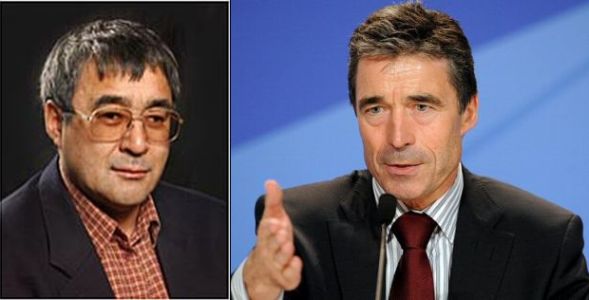
Left: Hans Enoksen, Greenland's chairman of the Greenland self-government board 2002-2009.
Right: Anders Fogh Rasmussen, Prime Minister of Denmark 2001-2009. Four months after the adoption of the Self-Government Act in 2009, he was appointed Secretary General of NATO for the period 2000-2014. He later moved permanently to Washington, where he ran a consulting firm, "Rasmussen Global". His son, Henrik Fogh Rasmussen, obtained American citizenship and entered American politics.
There are three reasons why the terms of reference have not been fulfilled.
1. From the very beginning, Hans Enoksen, chairman of the National Government of Greenland and especialy Anders Fogh Rasmussen, Prime Minister, organized the negotiations in such a way that they were given the character of two nations negotiating with each other.
2. The Greenlandic side they had generally their eyes firmly set on preparing for Greenland's independence - thus understanding that the self-government for a large part of the Greenlandic legation members alone has had to serve the overall purpose of being a springboard to real independence.
3. But the most decisive reason why the law became as it did, must be the Danish politicians' unwillingness to preserve the Commonwealth and their lack of political will to support Denmark and Danish interests. They have been too preoccupied with making everything look good and humane from a foreign point of view.
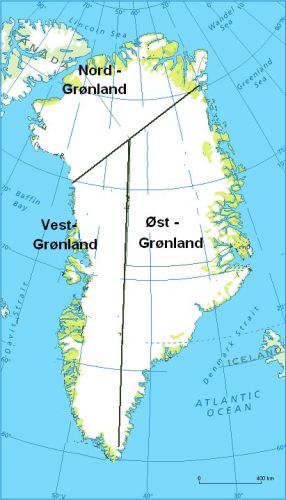
Greenland.
Moreover, why should an independent Inuit state have North and East Greenland with all its resources donated on top of the hat? Inuit's homeland is West Greenland and the extremely few indigenous inhabitants living in East Greenland have a completely different culture. East and North Greenland have primarily been explored by Danish polar explorers.
In reality, Denmark's expenditure on Greenland is much larger than the direct financial support. Part of the expenses, for example, go over the defense budget. Helicopters, four inspection ships, three inspection cutters, which are built solely as they are, to be able to operate in icy waters, cost about 1.5 billion a year in operation and depreciation. In addition, there are expenses for cash benefits and other support for Inuits who choose to live in Denmark.
As early as 1976, the then Social-Democrat Prime Minister Anker Jørgensen set up the possibility of Greenlandic independence: "There is nothing to play dice about" , he told Kalaallit Nunaata Radioa - Greenland Radio - when the Greenlandic left-wing party Siumut demanded that Greenland gained ownership of the underground. If the Greenlanders wanted ownership of the underground, they would have to breakaway from Denmark, Anker Jørgensen said.
Since then, the Danish politicians, all of them except the Danish People's Party, have given it all away.
The Self-Government Act is, in fact, in practice an approval that Greenland can leave the Commonwealth on the very day they have found enough oil and minerals to think they can manage on their own, and then keep the resources to themselves.
The Danish politicians seem to imagine that the Inuits are the original Greenlanders, who have lived in the country "always" until the imperialist Danes came and disturbed their originally idyllic life in harmonious connection with nature. Therefore, Danes should feel guilty and give the ambitious Greenlandic politicians everything they ask for.
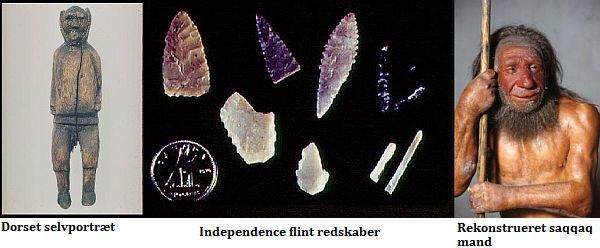
|
But in reality, the Inuits are not Greenland's indigenous peoples any more than other historical hunter-gatherers and Scandinavians are.
Besides the Norsemen, at least five different people have immigrated to Greenland over time. They were probably all of different ethnic types and spoke different languages. The Inuits, who today live in Greenland, arrived a few hundred years later than the Norsemen. They immigrated from the north, and the Norsemen came from the south.
Around 2,500 - 1,800 BC. the first immigration to Greenland took place. They came from Canada and followed the musk oxen across the ice and settled in Peary Land high in the north. They are called the "Independence I" people. No one knows how they looked like and what language they spoke. Greenlandic sources often call them "Eskimos", but we only know their habitats and flint tools, they could have been red-haired or dark-haired, we do not know.

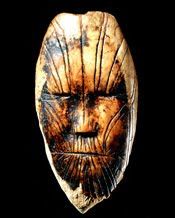
|
Left: Norsemen and Inuits around the year 1100 AD. - The Norsemen arrived as early as 985 AD.
Right: Independence II mask in ivory.
Around 1400 - 700 BC. came a hunter people, called the "Saqqaq" culture, they settled along the coast of West Greenland from Upernavik to Godthåb. At the same time, another people belonging to the "Independence II" culture came to North Greenland. Based on a gen-analysis of a few hairs, the University of Copenhagen has recreated a Saqqaq man, who does not look particularly Eskimoic.
However, both peoples succumbed to a cold spell that began in 400 BC. and lasted until about 200 AD.
The "Dorset" people arrived around or just after year 0 and settled in West Greenland. However, the archaeological traces of them disappear 600 to 700 years ago. They were driven out and annihilated by the Inuits, who came from Baffin Land to Greenland around 1200 AD. via the Thule area, from where they slowly spread south.
In 1954, Master of science Jørgen Meldgaard participated in an international archaeological expedition, which aimed to explore the remains of Dorset settlements on the Melville Peninsula and the Baffin Islands. They found 208 Dorset houses on the Melville Peninsula and 48 on Jens Munk Island. He wrote an article about the results of the expedition.
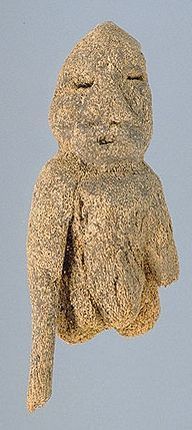

Left: A Dorset self-portrait.
Right: Dorset self-portrait from Baffin Island.
The Inuit called the Dorset people Tunit.
There are still Inuit legends about them. The Inuit myths tell that the first inhabitants were "giants", that is, people who were taller and stronger than the Inuits, yet easy to intimidate and chase away. It is said that "they were very skilled walrus and seal hunters. Wearing long cloaks with large collars they stood waiting for the seals to come up to draw air by their breathing holes. When the prisoners came home with walrus, they were very tired, but as soon as the women appeared outside their houses, they gained new strength," for, as the legend says, "they loved their women and children very much.
The Inuits from Igluik told the expedition that Tunits were good reindeer hunters, who could kill the reindeer on foot only armed with spears. They did not know the bow and arrow. In the winter, they caught seals at the breathing holes in the ice. Another important prey was the walrus; and here the legendary strength of the Tunits was of great help, especially in the transport home, for they had no dogs, but only a short sleigh, which they pulled themselves.
"The island of Ugilt south of Alarnek was Tunit's last living place," reported old Arnanguanq to the expedition participants. "Often they had to go very far on the ice to get the walruses, and therefore they were tired, despite their strength, when approaching Uglit. But then the women just needed to show up outside the houses to bring the power back to the hunters, for Tunit was very happy for their women. - Tunit was chased away by our ancestors, often after battle. Our ancestors liked to fight a lot, just like white men do today."
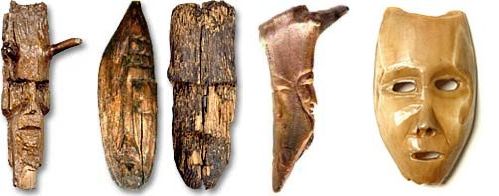
Dorset self-portraits carved in bone - They do not look very Eskimo-like, the first three look more like Europeans.
We note that the Inuits are not an unconditionally peaceful people, when they felt they had superior force. They did not refrain from a genocide of the Dorset people.
The first Scandinavians settled in southwest Greenland in 985 AD.
Some hundred years later, around 1200 AD, the "Inuit" immigrated to northern Greenland and spread slowly south along the west coast of Greenland.
Erik the Red and his men settled in 985 AD. at the bottom of one of the lush and sheltered fjords in southwest Greenland at the later Julianehåb, where he built the farm Bratthalid. He was quickly followed by new immigrants. There were three settlements with between 3000 and 5000 inhabitants in total. This corresponds approximately to the population of Copenhagen at the same time.

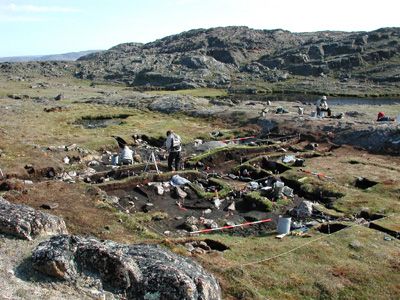
|
Top: Norse settlements in Greenland.
Below: Excavation ongoing on Baffin Island, where a possible Norse house has been found.
When the Norsemen settled in Greenland, the country was uninhabited. The Inuits had not yet arrived in Greenland from Canada and not at all to the southern part of Greenland. The Norsemen lived in West Greenland for at least 560 years. This means that Scandinavians are at least as much Greenland's indigenous people as the Inuits, in fact more indigenous people as they cme first.
The largest settlement, the Eastern settlement, was centered around the present Tunulliarfik and Igaliku Fjords in southwest Greenland near Julianehåb. The Westerne Settlement was located at the bottom of the Godthåb fjord, and finally a smaller Settlement was located in the area around present Ivigtut.
Greenlandic wool was famous throughout Europe. For more than five hundred years it was spun into cloth in the dark Greenlandic farms, transported to the loading harbors and picked up by foreign skippers. The large Greenlandic farmers did not own seagoing ships, the settlements were for life and death dependent on ships coming from outside.
Wool was not their only export product. They also exported "svard-reip", which were twisted walrus skins. They were made by cutting the skin into endless narrow spiral strips, which were then braided together. They were used as anchor and mooring ropes.
The Icelander Arngrimur Jønsson (1568-1648) told about the Walrus: "This animal is found both in Greenland and in Iceland. From its skin, ropes and anchor-ropes were once made, and it is called in the language of ordinary people, both the skin and the rope that is made of the skin, svordur. Therefore, our poet Hallfred says that when one sees that the mooring rope will break in the storm so:

|
Hvalsø church in he Eastern Settlement - around Julianehåb.
Færum festar vorar
fer særok ad knøre
Svord tekur helldur ad herda --
It is also called svardreip, a word well known to our people. Both Icelanders and Greenlanders have often given walrus skins as a gift to Danish and Norwegian kings, and thereby won their friendship."
The Greenlanders also had a large export of walrus and narwhal teeth. Walrus teeth are ivory, which are not as big as elephant tooth, but finer in the bone, in addition, walrus teeth are not as easy to split. Greenlandic ivory could be found around Europe as decorations on bishop's and abbot's staffs, reliefs on travel altars and small chests and cans, buttons and jewelery.
In addition, they exported fur, skin, feathers and down.
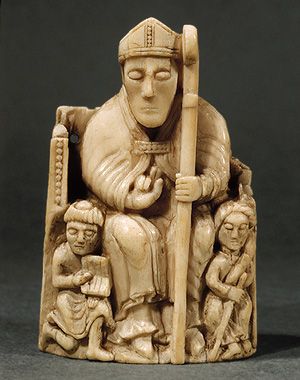
Medieval ivory figure carved in Greenlandic ivory. - some believe that the emergence of elephant tusks, ie ivory, created a crisis in the Greenlandic economy due to declining exports of walrus and narwhal teeth.
But at the beginning of the 1400's, Scandinavian shipping collapsed, and sailing on Greenland dimished.
Arngrimur Jønsson wrote: "I can not find anything else I can write about Greenland without stating that the sailing on Greenland did not cease until the year 1461. That was the year I said before that Andreas, the Bishop of Greenland, was in Iceland. But it seems to me very strange and as a sign that these people, and Greenland itself, were once subjects and taxpayers to Norway, and then to Denmark, when the Norwegian empire fell to the Danish kings, could disappear so suddenly and in less than a hundred years. However it has happened, it is clear that it has disappeared for us."
But there are indications that there was a ship connection to Greenland even later.
Dithmar Blefken traveled to Iceland on 10 April 1563 as a ship's chaplain on board one of two merchant ships. They arrived in Havnefjord in Iceland on 15 June 1563. He spent the winter in Iceland, and in the spring of 1564 went with Iceland's Danish governor on a discovery voyage in Greenlandic waters. The reason for this voyage of discovery is stated to be:
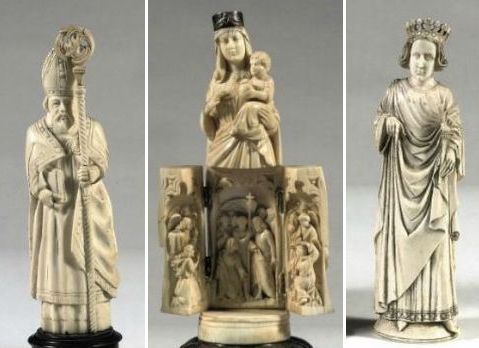
Ivory figures from the early Middle Ages (1100's) put up for sale at Christie - with big probably made of Greenlandic walrus tooth.
"In the monastery Helgafiel (Helgafell) in Iceland, which had been abolished and the proceeds confiscated to the King's Treasury, a blind monk had been left behind, who was born in Greenland, was of dark body color and had a broad face (oriundus ex Gronlandia, obscuro colore et amplo vultu) and had a miserable life in the monastery. The captain had him brought to him, in order to learn from him something true about the condition of Greenland. The monk explained that in his young years he had been confined by his parents in a monastery in Greenland ("coenbium D. Thomæ" - the monastery was founded in 1224) , but that when he was 30 years old he was taken out by the Bishop of Greenland, who was a native there, traveled with him to the Archbishop of Nidaros and left the monk, on the return journey from there, in Helgafells Monastery. This happened after his statement in the year 1546 - Greenland was only sparsely populated; The inhabitants had no cattle, and therefore lived only on fish - "
As the blind monk had arrived in Iceland, there must have been a ship connection to Greenland as late as the year 1546.
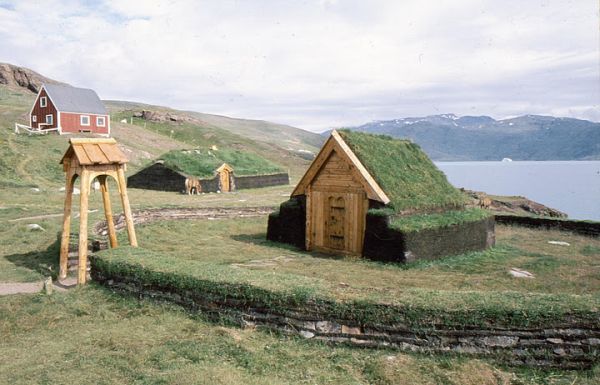
|
Reconstructed Norse church and longhouse in Qassiarsuk.
Greenland is explicitly mentioned in Christian 3's hand-binding contract from 1536 as part of the kingdom, and from 1666 the Greenlandic polar bear appears on the Danish-Norwegian coat of arms.
There is no shortage of theories about the reason for the Greenlanders' disappearance. Plague, insect attacks, harsh winters, Inuit attacks, emigration to America and attacks by British whalers have all been mentioned. Another possibility is that many of them emigrated back to Scandinavia, where they took over some of the many farms that became vacant after the plague. But no one knows, so far it has remained a mystery.
Niels Rasch Egede (1710-1782) tells an Inuit legend that, in the time when there were still Greenlanders in Greenland, 3 ships arrived from the southwest to plunder the survivors of the small colony. Hans Egede calls the Greenlanders Norwegians and writes that many of them were killed. Two of the three ships escaped, and the following year an entire fleet arrived to plunder and rob food. According to the Inuit legend, this was the reason why the last Greenlanders had to sail south.
"It is worth noting that the Inuit's name for Hvalsey, which was the Greenlanders' main island (Hvalsø). They call the island "Akpaitsivik", originating from "akpapok" (run). The origin of the Inuit place name is explained as that the Inuit forced them to flee from there, implying they were there first. We can see from Inuit folklore that at a much later time, in an already fully established Nordic society with the "herring place" at the bottom of Hvalseyjarfjordr, today "Kakortok", there is a meeting, a murder and a revenge campaign between an Inuit and one (more) "kablunak" (Norse man, Greenlander). This folktale is dated to the 16. century and therefore at the very end of the settlement period (see "Greenlandic Folktales (1863, 1. volume, 1. Tale of Oungortok) . In the Western Settlement, the Inuits arrive as late as the 14. century , where they are a threat to the Greenlanders (Greenland Historical Memorials 1845, 3. volume, p. 876) " (Flemming Rickfors).
In 1721, Hans Egede (1686-1758) arrived in Greenland, and a lasting connection was again established between Greenland and Denmark-Norway after 175 years.
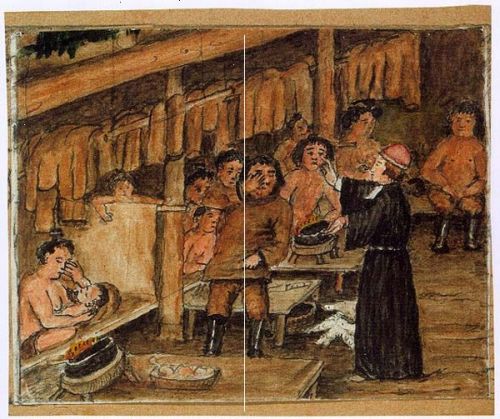
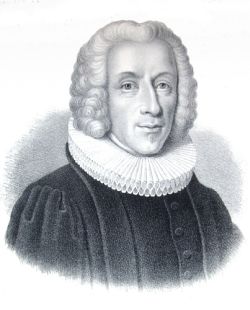
|
Left: Hans Egede scolds the shaman. Both shaman and a woman cries, the rest of the residents too seem concerned. - Aron of Kangeq 1822-1869.
Right: The Norwegian-born priest Hans Egede 1686-1758.
Hans Egede was supported by king Frederik 4. The private Bergen company gained a monopoly on the trade, but gave up as early as 1726, and the king's coffers took over the support. When financial results failed, Christian VI in 1731 ordered that the offices in Greenland should be closed. However, with reference to the many baptized Inuits, Hans Egede succeeded in getting the work continued. In 1734-50 under the monopoly of the Danish merchant and landowner Jacob Severin, and in 1750-72 under the Almindelige Handelskompagni.
By 1776, most of the colonial settlements had already been established on the West Coast from Julianehåb (Qaqortoq) in the south to Upernavik in the north. From this year, the Royal Greenland Trade gained a monopoly on trade on Greenland, and this continued until 1950.

The steam schooner Hans Egede on a Bing and Grøndal plate - It managed to get away from Copenhagen before the occupation and then sailed between Greenland and the USA. It departed from Ivigtut on 29 February 1942 with a course towards the American port, and on this voyage it was torpedoed by a German submarine. All 23 men on board died, including 3 Inuit crew members.
The most pressing problems in Greenland were of an economic nature. In the 19th century, the Greenlandic population had grown from almost 6,000 to just over 11,000 inhabitants on an unchanged business basis. At the turn of the century, the catch of seals did not seem to be able to increase, and therefore in 1906 sheep breeding was introduced in the southernmost part of Greenland. In addition, commercial fishing for halibut was launched from 1908, while the many experimental fishing for cod only began to give results from around 1917.
The Grand Greenland Commission wrote in its comprehensive report from 1950, implemented in eight laws, the guidelines that came to apply to the next fifty years. The main idea behind this gigantic development program was to modernize the Greenlandic fishery with Danish private companies as teachers. In addition, the infrastructure had to be expanded.
With the Constitution of the Kingdom of Denmark of 1953, Greenland became an integrated into Denmark, whereby two members of the parliamment were to be elected in Greenland.
The infrastructure, education and health care were greatly expanded. In the period 1952-1963, about 3,000 homes were built, the hospitals were expanded and the tuberculosis was almost eradicated from 1963.

|
The Greenland ship Hans Hedtoft is embarking on its maiden voyage in 1959. The ship was considered sink-free, as it had many waterproof bulkheads and was ice-reinforced.
The dramatic population growth necessitated the expansion of the cities, which should be centers of a sea-going year-round fishing. Since the private Danish investment proved insufficient, authorities began in late 1950's to build fish factories and buy trawlers for the fishing that should be the economic base. However, the projected cod fishery declined drastically from the mid-1960's, only to be slowly replaced by the shrimp fishery as the main primary occupation.
The steam schooner, Hans Egede, sailed on Greenland for 22 years. It managed to get away from Copenhagen before the German occupation and then sailed between Greenland and USA. It sailed from Ivigtut on 29 of February 1942 with course towards an American port and on this voyage it was torpedoed by a German submarine. All 23 sailors on board died, including 3 Inuit crew members.
The brand new and ice-reinforced "Hans Hedtoft" sank on its maiden voyage off Cape Farewell in 1959 with all 55 passengers and 39 crew members on board, only one lifebuoy was ever found.
The Danish polar explorers Knud Rasmussen, Ejnar Mikkelsen and Peter Freuchen and many others explored northern and eastern Greenland. Mylius-Erichsen, Høeg Hagen and Jørgen Brønlund died during the Denmark expedition to North Greenland.

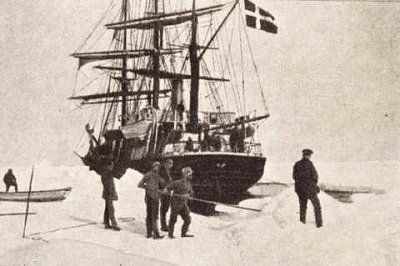
|
Left: Three members of the great Danmark expedition, which mapped Northeast Greenland 1906-1908: Harald Moltke, Ludvig Mylius-Erichsen and Knud Rasmusse. Photo wikisource.
Right: The expedition ship Danmark in the Northeast Greenland ice in 1907.
Had it not been for the responsible and persistent Danish efforts in Greenland, today there would not have been living opportunities for 56,000 inhabitants - yes, there would not even have been so many inhabitants.
In the years between 1953 and 1979, prior to the introduction of the home rule, enormous subsidies were transferred from Denmark to Greenland; the Greenlandic municipalities achieved full compensation in relation to Danish municipalities. Also in the years up to 1953, while Greenland still had colonial status, large subsidies were transferred from the state to Greenland. Public expenditure in Greenland is still financed by Financial support from Denmark, which today amounts to just over 3.5 billion dkr. annually.
We often hear from modern Inuit politicians about Danish exploitation of Greenlanders throughout history. But the reality is that the flow of money has always gone the other way, and in return for this, the Danes have only received some sentimental stories about imperialist exploitation.
Can Greenland become the Arctic answer to the wealthy emirates in the Middle East? Perhaps? If Greenlandic corporation taxes and taxes on extraction of oil, gold, diamonds, lead and other minerals can one day in the future cover the Danish financial support, Greenland's politicians are ready to say goodbye to the economic safety net from Denmark of 3.5 billion kroner annually.
Kuupik Kleist from the left-wing party Inuit Atagatigiit states that there is no doubt that the day Greenland no longer needs Danish subsidies, the entire cake of oil revenues then will go Inuit government.
"From the Greenlandic side, we are willing to negotiate with Denmark. It might be in 30 years", Kuupik Kleist said in a comment on a Danish wish that Denmark could possibly get a share in the oil billions, the day Greenland stands financially on its own two feet.
The US Geological Survey's assessments and statistical calculations show that the oil and gas resources in the North Sea converted into oil correspond to small 100 billion barrels of oil. The state geologist estimates, i.a. on the basis of the USGS 'assessments of the resources in Northeast Greenland, that in the seas around the whole of Greenland, between a third and a half of what is of oil in the North Sea can easily be hidden.
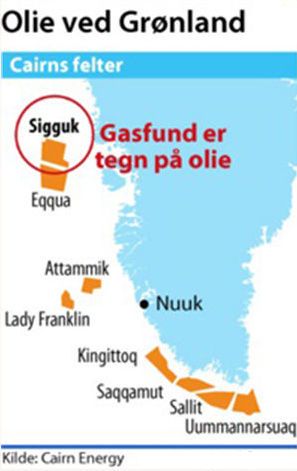
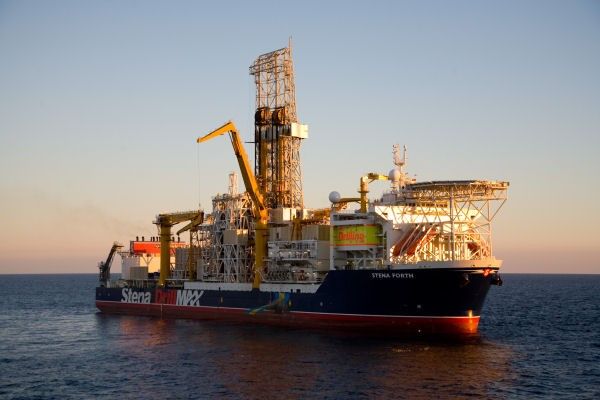
|
Top: Cairn industry - gas discovery at the Sigguk field off West Greenland..
Below: The drilling ship Stena Forth performs test drilling off Greenland for the Cairn industry.
In 2007, the British oil company Cairn said it had found gas in the Sigguk field off West Greenland. It is considered a sign that oil is present.
The Australian mining company Greenland Minerals and Energy will start extracting the highly coveted rare earths by the beginning of 2016 at the latest. "When we started the project, we counted on 25 and 30 years of production. Now we are up to over 100 years of production. And we are not done uncovering at all. We have drilled 70 km of test wells, and much remains to be done", says Ole Ramlau-Hansen, CEO of Greenland Minerals and Energy.
With a payment of 200 million dkr, the mining company has just secured the exclusive right to investigate in Kvanefjeld. But in return, the director predicts that the deposit will develop into the world's most profitable production capacity in the company REE industry, Rare Earth Elements. The company estimates that it has invested between DKK 1.5 and 2 billion in mining in Kvanefjeld in 2016.
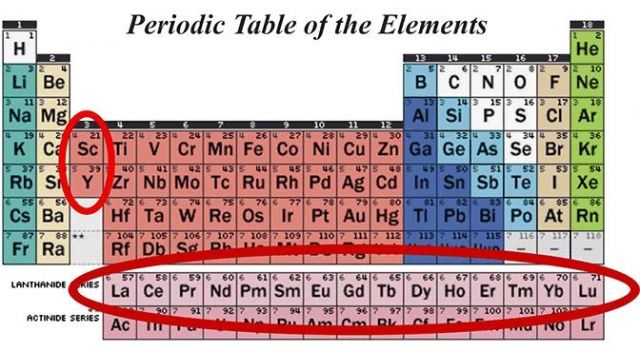
|
The rare earths - in the coming years we will hear much more about these 17 metals from the middle of the periodic table with names like lanthanum and neodymium that are difficult to pronounce.
Another Australian company, Platina Resources, has just completed its investigation south of Ittoqqortoormiit (Scoresbysund), in the Archipelago, and is awaiting analysis results. They have completed 6,000 meters of deep diamond drilling in the gold zone and are eagerly awaiting the analyzes that will be carried out in Canada. On that basis, the company will prepare a business plan. According to Platina Resources, the 141 km2 Skærgården concession contains one of the world's largest known gold and palladium depots.
Further south in Kringlerne, between Narsoq and Qaqortoq, another Australian company, Rimbal Power Resources, is now in the final stages of exploration for the rare earth eudialyte. The plan is to produce one million tons of eudialyte a year and employ at least 80 employees in the mine.
London Mining Plc announced on 21 February 2011 the results of a preliminary investigation carried out by SNC. Forecast is of a mine that can mine 15 million tons of iron ore a year at Isua, which is located 150 km northeast of Nuuk. Adm. Director Graeme Hossie stated: "Isua will be a significant new producer in an important new iron ore area. We expect production of 15 Mtpa premium quality iron ore starting in 2015 with an estimated post-tax present value of USD 2.5 to 4.5 trillion USD after tax - We have full support from the Government of Greenland and we are reviewing the options for the optimal financing. structure for construction."
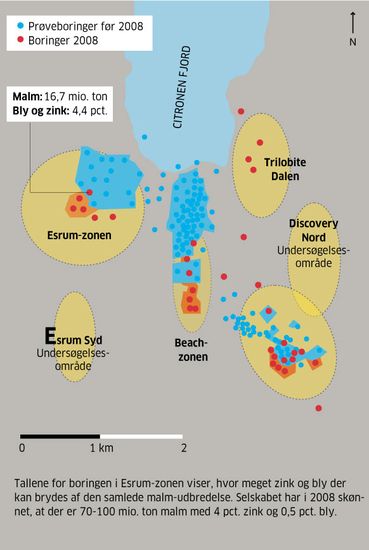

|
Left: Existence of zinc and lead in Citron Fjord.
Right: Citronen Fjord is located in North Greenland, which will only have open water and shipping options a few months a year.
In 1993, the mining company Platinova A/S discovered a large zinc and lead ore deposit at Citronen Fjord in North Greenland. The deposit is located in the National Park in North and East Greenland. It is somewhat similar to zinc-lead deposits in identical geological environments in Alaska. In these places, mines have existed for years. Since 1993-1998, Platinova A/S has drilled about 34 km in 143 holes. Based on these drilling results, Platinova A/S has estimated a resource of more than 20 million tonnes of ore containing 7% zinc and 1% lead. The Citronen Fjord resources are larger than the lead-zinc deposit at Maarmorilik, but the concentration of the two metals is lower. The company is of the opinion that a mine in Citronen Fjord can be operated by icebreakers; in the two to three months in the summer, when the fjord ice is at a minimum, consumables can be brought in and the metal concentrate transported out.
An Australian company Ironbark Zinc is also active at Citronen Fjord with a zinc mine project, which they expect a lot from. The company is very optimistic and expects to extract 250,000 tons of zinc concentrate and 30,000 tons of lead concentrate per year. There is a shipping window of one and a half months, from mid-July to the end of August, when the fjord is ice-free, says Kim Ulrik Hansen from MT Højgaard. He believes it is possible to have an operation running all year round and ship for a month and a half. The processing plant will be completed on a barge in Iceland, from where the plant will be sailed to Citronen Fjord. An area will be excavated where the barge can sail in at high tide. When the water level drops, the barge settles to the bottom, and then MT Højgaard builds a dam to keep the water out. And then the plant will be ready for use.

|
Port for loading ships; the Nalunaq gold mine is several kilometers inland.
In 2004, Nalunaq, Greenland's first gold mine, opened in Nanortalik. It is a positive example that there are plenty of local jobs in mineral extraction. In addition to the 150 employees of Nalunaq and a Canadian mining company, local construction and catering companies have sprung up.
Avannaa Resources Ltd reported in 2011 that they have found a significant deposit of sedimented copper ore in J.C. Christensen Land in North Greenland about 150 km south of Citronen Fjord. Chiseled samples showed 0.8-3.4% copper together with 33-79 g/h silver and; excavated samples showed 12.5% copper and and 385 g/h silver. These results are considered extremely positive. Exploration director Stefan Bernstein stated: "The region has a very similar geology and mineralization system as the Kantangan supergroup in the Zambian copper belt - we believe that the area has the potential to contain a large volume of copper ore. We are making a significant effort to prove this."
Hudson Resources Inc. announced on 1 February 2011 that metallurgical tests had begun on the company's Sarfartoq rare earths project in southwest Greenland. James Tuer, President of Hudson, stated: "We are very pleased to start the metallurgical test work on the ST1 Zone. The results of this work will be an important component of our preliminary economic assessment, which we plan to finish in the first half of 2011. It will form the basis for an application for a 30-year mineral exploitation permit to the Minerals and Petroleum Directorate in Greenland, which we plan to submit in 2012."
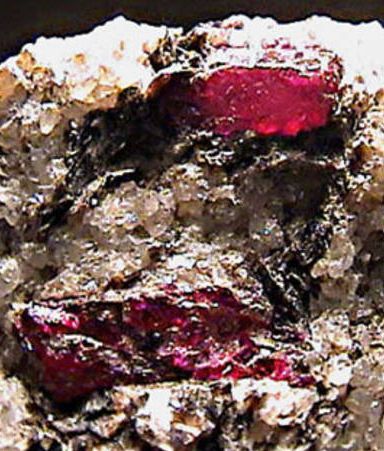
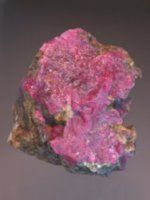
|
Left: Greenlandic rubies in the rock.
Right: 200 carat multicrystalline ruby stone from Aappaluttoq.
In a meeting with the interested stakeholders, True North Gems prepared a Project Briefing setting the strategy for the development of the Aappaluttoq area so that stakeholders can assess the project and its potential for both positive and negative effects. The company has also prepared a ruby and pink sapphire introduction, which is also available in Inuit language and Danish, which is intended to help understand the nature of the gemstones to be mined at Aappaluttoq. Nicholas Houghton, CEO and Chairman of True North Gems stated: "We are happy to start the SIA process and start direct discussions with people in Greenland about the benefits of this project. I believe that the entire Greenlandic people will benefit from the project, either directly from education and employment, through the spin-off from these activities, or from the increased tourism that the worldwide marketing of Greenlandic rubies will bring. I look forward to a constructive process with maximizing the benefits we can deliver and building a lasting relationship with the people of Greenland."
Hunter Minerals Pty Ltd has sent the following information to MINEX News about an unprecedented magnetite-rich deposit in South Greenland, licensed since 2004. The Gardar project, located in the Isortoq area east of the Nunarsuit Peninsula, proved to be a hiding place for impressive magnetic and electromagnetic geophysical anomalies which after drilling tests were found to contain magnetite-rich compounds. Drilling indicates resources of at least 1 trillion tonnes with concentrate grades of 62.6% FeO, 19.1% TiO2 and 0.32% V2O5. A preliminary investigation has been carried out.
An olivine mine has already been opened in Maniitsoq Municipality.
These are just some examples of the many projects that are underway in Greenland.
The Americans have always been very interested in Greenland.
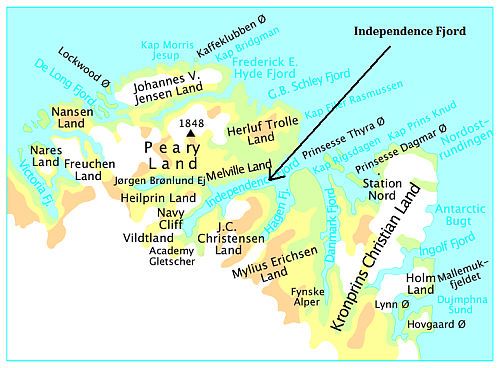
Peary Land with Indenpendence Fjord.
The American polar explorer Peary claimed in 1892 that Peary Land was an island separated from Greenland. This idea was no doubt motivated by that he wanted to claim this island for the United States.
Peary came to the bottom of Independence Fjord in 1892. Here he meant to be able to state that Peary Land was an island, separated from Greenland by the so-called Peary Canal, a continuation to the NW of Independence Fjord.
However, in 1907, the Denmark expedition traveled the northern coast and found that the Peary Canal did not exist. T 1920-23, Lauge Koch traveled as the first around Peary Land, where he ia. conducted geological surveys.
In the same way as the Soviet Union kept occupied the countries of Eastern Europe that they had won during the war against Nazi Germany, so the United States kept its foothold in Thule in Greenland, which they had gained because of the war.
In 1946, the Truman administration made an actual bid to buy the rest of Greenland. It was rejected by Denmark without hesitation. Foreign Minister Gustav Rasmussen was completely taken aback by this possibility. He said to the American ambassador to Denmark a month later: "While we owe America a lot, I do not feel that we owe them the whole island of Greenland."
Ever since, the U.S. administration has had many plans on how they could come into possession of the rest of the island of Greenland. They are all based on the assumption that the United States has a deadly enemy, namely Russia, formerly the Soviet Union. Greenland is indispensable for them in the defense against this terrible enemy, and therefore it will be legitimate and fair if the United States takes over Greenland.
The Americans have not forgotten Greenland. They are ready with a plan, when Greenland emerges as a new independent nation. They expect oil and gas to be found in the Greenlandic underground. And when that happens, Greenland will apparently breakaway from Denmark once and for all, it is estimated.
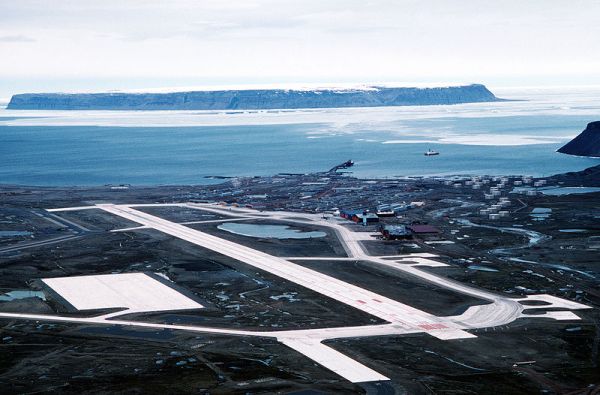
|
The American Thule Air Base in North Greenland.
The United States is apparently convinced that Greenland's independence is just around the corner. "The United States has a unique opportunity to influence the circumstances in which a new independent state emerges,," wrote Ambassador to Denmark, James Cain, in an internal memo (from wiki-leaks).
James Cain, who was ambassador to Denmark between 2005 and 2009 - while Danish politicans were preparing the Self-Government Act - also called on the United States to strengthen all contacts and ties with Greenland and establish "a small and periodic American presence in the capital of Greenland as soon as practicable." Cain has also stated that he has introduced American financiers in New York to Greenlandic politicians to secure American investments on the island.
Greenland gained home rule in common with Denmark in 1979, while in 2009 a self-government scheme was adopted. According to the report, a Greenlandic representative has jokingly told the American ambassador that Greenland is "only an oil discovery" from gaining economic and political independence.
The ambitious Greenlandic politicians may imagine that they can manipulate Danes and Americans from a position of wealth, so to speak.
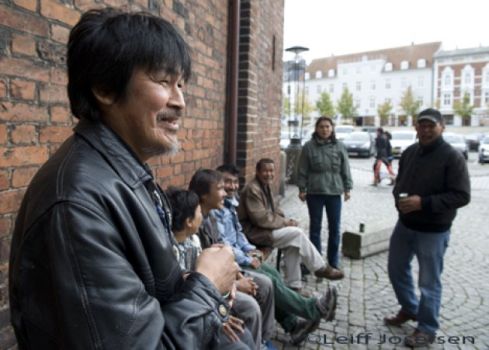
Inuits in Aarhus. Photo: Leiff Joensen.
But the Greenlandic population is of the size of the population in Vejle, namely about 50,000 people. They live immensely scattered, they are generally poorly educated, quite alcoholic and reportedly have poor work discipline. They can not establish either defense, police, courts or a real foreign policy.
In an independent Greenland, any nation or just a large international company would be able to establish itself and pretty much do what they please. The Greenlandic politicians would only be able to give some speeches in Godthåb (Nuuk) and issue some statements. They will not be able to exercise any real power.
On the day when Denmark is no longer present on the island, the United States will take over as the most natural thing in the world.
For several hundred years, generations of Danes have contributed to the development of Greenland. Billions have been spent on developing the country, paid for by Danish taxpayers. When the Danes returned to Greenland, it was a poor hunting community that provided food for probably less than five thousand inhabitants. Today, there are more than ten times as many residents who enjoy a very significantly higher standard of living.

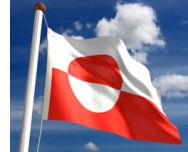
|
Left: Flag of the Scandinavian countries.
Right: The flag of Greenland.
Then one could imagine that the modern Greenlandic politicians would feel a kind of respect and gratitude towards Denmark. But that does not seem to be the case. They have found it opportune to take on a kind of sacrificial role as victims of the evil Danish imperialism of the past.
If they had felt any respect and gratitude for decades, even centuries of Danish efforts, they would not have changed all the names of the Greenlandic cities from the original, Godthåb, Julianehåb, Holsteinsborg and so on, to some more or less newly invented names in the Inuit language. The day they fulfill their hot dreams of full independence, they will probably also give Greenland a new Inuit name.
All Scandinavian flags are cross flags; The national flags of Norway, Sweden, Iceland, Finland, the Faroe Islands, the Åland Islands and Denmark are all cross flags; Only the ambitious Inuit politicians in Greenland wanted to demonstrate an aggrieved alone with a different newly invented Inuit flag.
Only Danish politicians can come up with something like the Self-Government Act.
With a magnificent hand gesture, they have donated the kingdom's Greenlandic resources to the local Inuits - without asking the Danish and Faroese people. Nowhere else in the world has any nation left such significant resources to such a small ethnic minority group. Brazil, for example, has insisted that Amazomas' resources belong to the whole of Brazil, not just the Native American tribes who live there.

Prime minister Poul Schlütter set a bad example by giving the Faroe Islands the right to the archipelago's underground.
In exactly the same way, the people were not asked when the politicians in 1982 decided that Denmark should be an immigrant country - a decision that has had, and will have, enormous significance for Denmark. A decision they also made in invoking human rights, democracy, tolerance and respect for other races and religions.
The then Prime Minister Poul Schlüters set a bad example in 1992, when he made an agreement with the Faroese National Government that the Faroe Islands only have the right to the archipelago's subsoil. On this occasion, voters were not asked either.
On the other hand, the voters were asked in the case about the constitutional amendment concerning the female succession. A completely unnecessary vote as there were no shortage of princes. Politicians simply allowed voters to feel themselves important by giving them the opportunity to discuss women's equality and democracy-theoretical details.
We have been very unlucky with our political leaders. Denmark will become a very small and poor country thanks to the bad decisions they have made on behalf of the people.
The most important motivation of Danish politicians is probably to make a good impression on their international political colleagues. The future of their own people does not seem to be very important to them. They say it themselves quite often with statements like: "The rest of the world is wondering about this and that decision", or "Abroad, Denmark is considered an intolerant and closed country" and the like.
Even if one hypothetically imagines that the politicians had to accept an Inuit state in Greenland due to foreign pressure, it is difficult to understand why such a state must also have allocated North and East Greenland with all their resources. Inuit's original home from the late Middle Ages is West Greenland, and there have never been significant Inuits living in the other parts of Greenland. The Inuits would not have known what is on the other side of the inland ice if the Danes had not told them.
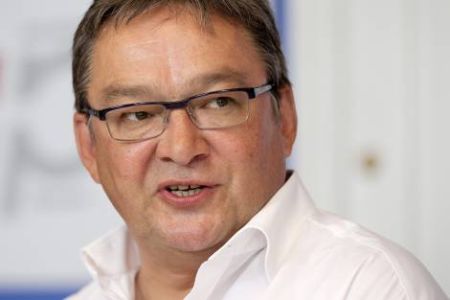
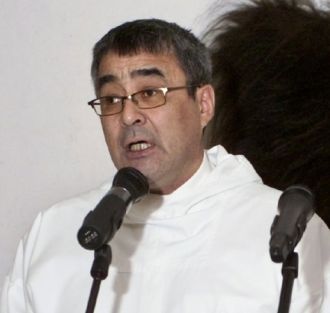
|
Left: The chairman of the Greenlandic self-government Kuupik Kleist.
Right: Chairman of the Greenland National Board Hans Enoksen.
The ambitious Greenlandic politicians seduce the poorly educated Inuits into believing that Greenland can exist as an independent state.
The chairman of the Greenlandic Self-Government, the left-wing Kuupik Kleist, recently presented at a future conference in Nuuk a vision in which Greenland already has its own constitution in ten years' time - still within the framework of the Danish kingdom, but in a looser association with Denmark than the Commonwealth that today connects Denmark, Greenland and the Faroe Islands.
In his New Year's speech, Hans Enoksen, chairman of the National Government, has stated that the Greenland government will work for a quick takeover of responsibility for foreigners and immigration. He refers to the fact that Greenland expects a large shortage of labor in the near future. He is probably thinking of introducing cheap Asian labor to the many projects, as Inuit employees are not much sought after. If the projects fail, the Danish taxpayers can always pick up the social shards.
| To start |